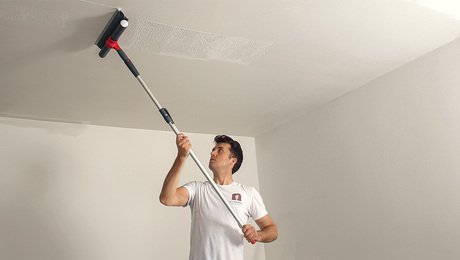*
My partner and I just started our own construction company about 6 months ago. We each worked for different companies before this. The guy I worked for would run deck boards tight claiming that after time they are all going to shrink up and have gaps, so per-gaping the deck boards would just result in even bigger gaps after time. The guy my partner worked for would always gap the deck boards with a carpenters pencil claiming this left room for expansion and contraction then the gap would always stay about the same. Any suggestions? This is on redwood decks.
Discussion Forum
Discussion Forum
Up Next
Video Shorts
Featured Story

Skim-coating with joint compound covers texture, renews old drywall and plaster, and leaves smooth surfaces ready to paint.
Featured Video
Builder’s Advocate: An Interview With ViewrailHighlights
"I have learned so much thanks to the searchable articles on the FHB website. I can confidently say that I expect to be a life-long subscriber." - M.K.

















Replies
*
Eric,
In my area what we do is space redwood and cedar with a pencil, they're very dry from the lumber yard. Treated decks we run tight because the lumber is very wet. They shrink so much, that when they do dry out the gaps are 1/4 to 3/8 in.
John
*Eric, I agree with John. I work on the south shore of Long Island, New York, sometimes right on the ocean, and if it's dry mahogany, or some other hardwood, you need to space it. We recently had a mahogany deck swell up and buckle, and it was spaced with 10D commons. If your using CCA, we usually see quite a bit of shrinkage.
*I'm in agreement with John we'll gap the dry stuff like cedar, redwood, and doug fir but when it comes to pressure treated we lay it tight. Once upon a time when I was young and just getting started in the trade the guy I worked for had me space with a pencil. When I started out on my own I did them that way too.That was a big huge mistake because my clients were calling me back the following year because there were big huge gaps in thier decks. Some of the gaps we so wide up to 1/2" that they could represent a twisted ankle danger to someone lets say in high heels. I then switched to spacing using a 16d nail or so but the gaps that I was getting then were still large enough (up to 3/8") and irregular enough that I began to lay the pressure treated tightly. Now after many many years of experience I try to steer my clients away from pressure treated as a decking material altogether. Hey it's great and I still use it for the structure but lets face it it's just never as attractive or as as stable a material as cedar, redwood, doug fir, mahogany, or pau lope.
*Eric, I work in the Pac NW and top most decks with "prodeck". It is cedar with kerfs (4) already cut into the bottom to help limit cupping. I always pack them tight and always end up with 1/4" to 3/8" gap after only a few months. I built my own deck spaced with the same 12d galvy I used to fasten down the cedar. I have up to 1/2" gap now, 3 years later. My two bits, for whatever it's worth. -Rich
*Eric,
View Image © 1999-2000"The first step towards vice is to shroud innocent actions in mystery, and whoever likes to conceal something sooner or later has reason to conceal it." Aristotle
*Joe, Good point, every situation is different. Building in Florida, we use a lot of pressure treated yellow pine and it often arrives on the jod site wet, really wet. As a rule we place it tight, but I can remember doing an atrium where I wish I hadn't. The deck was placed on sleepers over a concrete slab with drain. The attium was about 12'x 20' with roughly half shaded by a trellis with automatic drip irrigation. The deck not only do not shrink it buckled.
*I can't tell you how many decks I built out of the back of my crappy old Nissan pickup. In our area, PT SYP is the norm, and it's so wet that you can wash your hands with the water that drips off it. We always make it as tight as humanly possible, and we end up with fairly consistent gaps after six months. I'd think about spacing more if the wood were double-dried or of a different species, though.
*Pro-Dek has been building 5/4"x4" tight knot cedar decks for years. Wet or dry we use a Stanley speed square for spacing.Decking should never be put on w/o a gap. Wood needs to breath. putting decking tight just traps moisture creating more shrinkage. check out our web site, Pro-Dek.com. and good luck
*i Decking should never be put on w/o a gap. Wood needs to breath. putting decking tight just traps moisture creating more shrinkage.I don't buy that by touching the edges of the boards, you have sealed so much surface area that the boards won't be able to loose the water trapped inside. If you're decking with a 2x8, do you have to rip them down the middle to get that extra surface area?In a couple of short weeks, the wet wood will have shrunk enough that there will be a gap anyway (unless you're building under an irrigation system I guess).And I'm lost completely on the third sentence.
*Ryan, In twenty-five years of carpentry my atrium deck is the only deck that has never shrank. 5/4 X 6 is the smallest decking I use and it definitely shrinks. Cedar or mahogany may not shrink like pt, but I would never a speed square to gap decking. With pt decking, you would end up with 3/8 to 1/2 gap. I would consider that dangerous. I still install my decking tight and take my chances.
*Pro-Dek,There you go again, referring people to your web site which, though a very nice site showing great work, offers no information to help answer the question.You build nice decks,i we get it.Rich Beckman
*Rich did you bother to read my reply?? I said we we use a Stanley speed square for spacing, putting down 5/4" x 4' tight knot cedar wet or dry, and believe me it is usually wet here in the Seattle area. Putting deckinf tight only traps more moisture. Wood needs to breath.Forget the site, I won't mention it again.
*These deck boards (2 x 6 CCA southern yellow pine) were installed in 1992, with no gap at all. The boards were butted tight. Because of the heat we have during the summer, these little suckers shrink big time. During the winter/wet months, the gap shrinks to about 1/8" to 3/16". The wood is always so wet when we get it that we MUST butt them tight or the gap that occurs when the wood dries would be out of this world.James
*Conventional way of thinking: If the boards you're putting down are wet, put them on tight. If they're dry, leave a gap. Local climate figures as well.If we put on wet PT boards, in a couple sunny dry days an eighth inch gap opens. A month in the summer and it's about a quarter.MD
*
My partner and I just started our own construction company about 6 months ago. We each worked for different companies before this. The guy I worked for would run deck boards tight claiming that after time they are all going to shrink up and have gaps, so per-gaping the deck boards would just result in even bigger gaps after time. The guy my partner worked for would always gap the deck boards with a carpenters pencil claiming this left room for expansion and contraction then the gap would always stay about the same. Any suggestions? This is on redwood decks.
Decks and moisture
I've been lucky enough to live in the same home I designed and built now for 20 years. I have replaced decks a couple times through these years. We live in a rain forest, on the Oregon Coast. 100 inches of rain a year. My first set of decks was a nail width apart. They filled with debris, and had to be cleaned with an old handsaw in the cracks as the pressure washer did too much damage.
Without large gaps on our decks, they fill with needles. The needles decompose, and moss grows. Any wood that is touching each other rots. If it holds dirt and moss, it rots quicker.
We're currently putting a wood deck over a large EPDM membraned roof that will be going to a rain water collection system. I'm planning on setting 1/2" gaps on this for ease of cleaning - both by blower, and pressure washer. Heels aren't that popular here.
I have found setting larger gaps - when the wood shrinks and expands, it's not noticeable. I can get 10 years out of my 2x6 cedar using cabots every 2 years. This year we are trying that "Eco Wood Treatment" boran salt stuff.